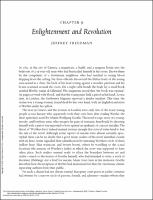Please use this identifier to cite or link to this item:
https://hdl.handle.net/20.500.12202/9847| Title: | Enlightenment and revolution |
| Authors: | Freedman, Jeffrey Raven, J. |
| Keywords: | The Enlightenment Revolution Printing --History. Books--History |
| Issue Date: | 2020 |
| Publisher: | Oxford UP |
| Citation: | Freedman, J. (2020). Enlightenment and revolution. In J. Raven (Ed.), The Oxford Illustrated History of the book (pp. 221-252). Oxford University Press. |
| Series/Report no.: | Stern College for Women: Faculty Publications;2020 |
| Abstract: | In 1783, in the city of Geneva, a magistrate, a bailiff, and a surgeon broke into the bedroom of a 19-year-old man who had barricaded himself in his room. Drawn there by the complaints of a downstairs neighbour who had testifed to seeing blood dripping from the ceiling, the three officials discovered the lifeless body of the young man seated in a chair, the back of his head resting against a wooden partition and his brains scattered around the room. On a night table beside the body lay a small book entitled Werther, traduit de l’allemand. The magistrate noted that ‘the book was opened’, ‘its pages covered with blood’, and that the young man ‘held a pistol in his hand’. A year later, in London, the Gentleman’s Magazine reported a similar incident. This time, the victim was a young woman, found dead by her own hand, with an English translation of Werther under her pillow. •The man in Geneva and the woman in London were only two of the many young people across Europe who apparently took their own lives after reading Werther, the short epistolary novel by Johann Wolfgang Goethe. The novel’s tragic story of a young, moody, and lovelorn artist, who escapes the pain of romantic heartbreak by shooting himself with a pistol, was reported to have ignited an epidemic of copycat suicides. The threat of ‘Werther-fever’ indeed seemed serious enough that several states tried to ban the sale of the novel. Although some reports of suicide were almost certainly apocryphal, there can be no doubt that a great many readers of the novel identified closely with its hero. Some signalled their identification by imitating Werther’s style of dress (yellow hose, blue waistcoat, and brown boots), others by travelling to the actual locations (the stations of Werther’s Leiden) at which the story was supposed to have taken place. Such readers seemed ready to efface the boundary between art and reality—much to the horror of Goethe himself, who had intended to write a work of literature (Dichtung), not a brief for suicide. Many years later in his memoirs, Goethe described how the reception of Werther had dramatized for him the ‘enormous chasm’ separating authors from their public. (from Introduction) |
| Description: | Book chapter |
| URI: | https://www.academia.edu/51324305/Enlightenment_and_Revolution https://hdl.handle.net/20.500.12202/9847 |
| ISBN: | 9780198702986 |
| Appears in Collections: | Stern College for Women -- Faculty Publications |
Files in This Item:
| File | Description | Size | Format | |
|---|---|---|---|---|
| Freedman 2020 Enlightenment_and_Revolution.pdf | 2.05 MB | Adobe PDF |  View/Open |
This item is licensed under a Creative Commons License

